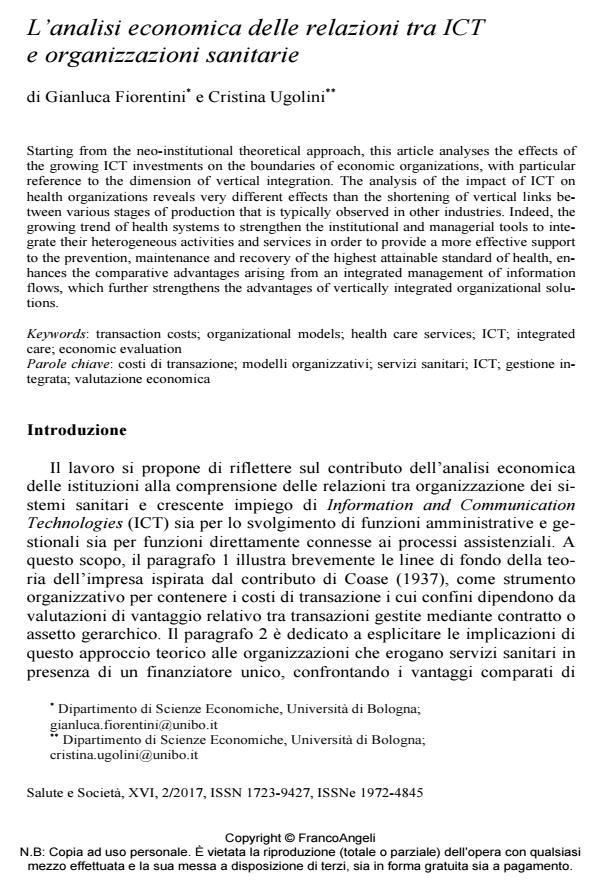L’analisi economica delle relazioni tra ICT e organizzazioni sanitarie
Journal title SALUTE E SOCIETÀ
Author/s Gianluca Fiorentini, Cristina Ugolini
Publishing Year 2017 Issue 2017/2 Language Italian
Pages 23 P. 42-64 File size 133 KB
DOI 10.3280/SES2017-002004
DOI is like a bar code for intellectual property: to have more infomation
click here
Below, you can see the article first page
If you want to buy this article in PDF format, you can do it, following the instructions to buy download credits

FrancoAngeli is member of Publishers International Linking Association, Inc (PILA), a not-for-profit association which run the CrossRef service enabling links to and from online scholarly content.
Starting from the neo-institutional theoretical approach, this article analyses the effects of the growing ICT investments on the boundaries of economic organizations, with particular reference to the dimension of vertical integration. The analysis of the impact of ICT on health organizations reveals very different effects than the shortening of vertical links between various stages of production that is typically observed in other industries. Indeed, the growing trend of health systems to strengthen the institutional and managerial tools to integrate their heterogeneous activities and services in order to provide a more effective support to the prevention, maintenance and recovery of the highest attainable standard of health, enhances the comparative advantages arising from an integrated management of information flows, which further strengthens the advantages of vertically integrated organizational solutions.
Keywords: Transaction costs; organizational models; health care services; ICT; integrated care; economic evaluation
- Hart O., Moore J. (1990). Property rights and the nature of the firm. Journal of Political Economy, 98: 1120-57. DOI: 10.1086/26172
- Buntin M.B., Burke M.F., Hoaglin M.C. and Blumenthal D. (2011). The benefits of Health Information Technology: a review of the recent literature shows predominantly positive results. Health Affairs, 30 (3): 464-71.
- Blois K.J. (1972). Vertical Quasi-Integration. Journal of Industrial Economics, 20: 253-72. DOI: 10.2307/209805
- Bresnahan T.F. and Trajtenberg M. (1995). General purpose technologies ‘Engines of growth’?. Journal of econometrics, 65(1): 83-108.
- Buccoliero L., Calciolari S. and Marsilio M. (2008). A methodological and operative framework for the evaluation of an e‐health project. The International journal of health planning and management, 23(1): 3-20.
- Chaudhry B., Wang J., Wu S., Maglione M., Mojica W., Roth E. et al. (2006). Systematic review: impact of health information technology on quality, efficiency, and costs of medical care. Annals of Internal Medicine, 144 (10):742–52. DOI: 10.7326/0003-4819-144-10-200605160-0012
- Coase R. (1937). The Nature of the Firm, Economica, 4; trad. it. La natura dell’impresa, in Impresa, mercato e diritto, Bologna, Il Mulino, 1995, 73-96.
- Danzon P.M., Furukawa M. (2010). E-Health: effects of the Internet on competition and productivity in health care. In: Litan R.E. and Rivlin A.M., eds., The economic payoff from the internet revolution. Brookings Institution Press.
- Davis F.D. (1989). Perceived Usefulness, Perceived Ease of Use, and User Acceptance of Information Technology. MIS Quarterly, 13(3): 319-340. DOI: 10.2307/24900
- Dietrich M. (1994). The Economics of Quasi-Integration. Review of Political Economy, 6(1): 1-18. DOI: 10.1080/0953825940000000
- Draka M., Sadun R., Van Reenen J. (2006). Productivity and ICT: A Review of the Evidence. CEP Discussion Paper No 749.
- Enthoven A. (1988). Theory and practice of managed competition in health care finance. Amsterdam: North Holland.
- France G. (1998). Healthcare quasi markets in a decentralised system of government. In: Bartlett W., Roberts L.A., Le Grand J., eds., Quasi-market reforms in the 1980s: a revolution in social policy. Bristol: The Policy Press.
- Goldzweig C.L., Towfigh A., Maglione M., Shekelle P.G. (2009). Costs and benefits of health information technology: new trends from the literature. Health Affairs, 28(2): w282–93.
- Grossman S., Hart O. (1986). The Costs and Benefits of Ownership: a Theory of Lateral and Vertical Integration. Journal of Political Economy, 94: 691-719. DOI: 10.1086/26140
- Light D.W. (2001). Comparative institutional response to economic policy managed competition and governmentality. Social Science & Medicine, 52: 1151-66. DOI: 10.1016/S0277-9536(00)00236-
- Le Grand J. (2002). Further tales from the British National Health Service, Health Affairs, 21(3): 116-129.
- Louis D.Z., Robeson M., McAna J. et al. (2014). Predicting risk of hospitalisation or death: a retrospective population-based analysis. BMJ Open, 4: e005223.
- Malone T., Yates J., Benjamin R. (1987). Electronic Markets and Electronic Hierarchies. Communications of the ACM, 30: 484-497. DOI: 10.1145/214762.21476
- Odlyzko A. (2012). The volume and value of information. International Journal of Communication, 6: 920-935.
- Solow R. (1987). We’d better watch out, New York Times Book Review, July 12, page 36.
- Telecom Italia (2015) Italia connessa. --Testo disponibile al link: http://italiaconnessa.telecomitalia.com/sites/default/files/ItaliaConnessa2015.pdf
- Ugolini C. (2004). Verso una rilettura del modello di concorrenza amministrata?. Rivista delle politiche sociali, 4: 197-212.
- Williamson O. (1975). Market and Hierarchies: Analysis and Antitrust Implication. New York: Free Press.
Gianluca Fiorentini, Cristina Ugolini, L’analisi economica delle relazioni tra ICT e organizzazioni sanitarie in "SALUTE E SOCIETÀ" 2/2017, pp 42-64, DOI: 10.3280/SES2017-002004